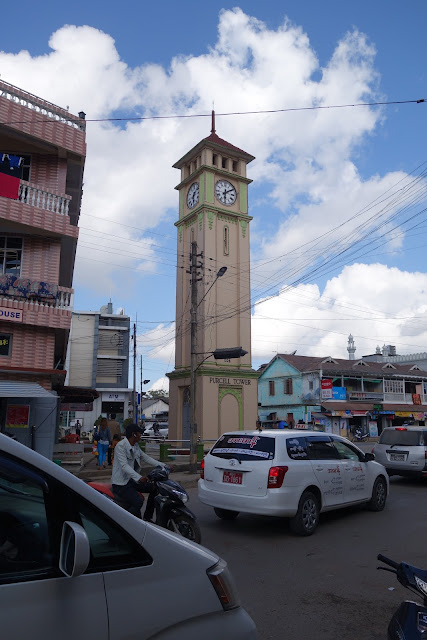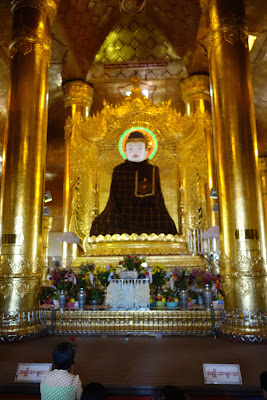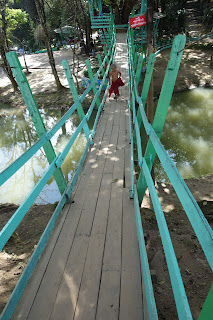
My Trip to Burma: The charming town of Pyin Oo Lwin, and the beautiful Kandawgyi Gardens.
Today we got an early start. We were picked up at our hotel by Marn and our driver, and off we went. Sixty-five kilometers east of Mandalay, on the western edge of the lush Shan Plateau 1070 meters above sea level, is the town of Pyin Oo Lwin, sitting far above the dust of Central Myanmar. It was established relatively recently (1896) as a military post providing refuge from the stifling heat of Yangon and Mandalay. It was originally named Maymyo, or “May Town”, after Colonel James May, the town’s first governor, who was stationed on an early army base here. Once the railline to Lashio was completed, the town became the official summer capital of the British Burma administration. While Mandalay and Pyin Oo Lwin are only 65 km apart, they feel a world apart. Mandalay marches on to being a modern developed city, while Pyin Oo Lwin nurtures and builds on its past.
Here are some ladies selling Shan noodles.
All the food looked interesting. I wanted to try it all.
There was every kind of produce you could imagine, as well as herbs, spices, meat, and fish. Dry goods, tool.
This is one mean lookin’ lady! (Actually, she was very nice. I just caught her off guard holding her bowl of soup.)
I like the way they arrange these leaves.
 After the market, we went back to the car to drive around the town. First thing we saw was the 1936 Purcell Tower, in the center of Pyin Oo Lwin’s compact town center. The center of town is a bit more down to earth than the posh suburbs, and is home to large ethnic Indian and Nepali communities, the descendants of soldiers and laborers from across the subcontinent who moved here under British rule. Many of these folks now run shops selling fruit wine, jam, and woolly jumpers for which the town is known. Mosques and Hindu temples abound. In fact, there was a mosque just a few yards up the street from the Purcell Tower. See below. Note the striking minaret.
After the market, we went back to the car to drive around the town. First thing we saw was the 1936 Purcell Tower, in the center of Pyin Oo Lwin’s compact town center. The center of town is a bit more down to earth than the posh suburbs, and is home to large ethnic Indian and Nepali communities, the descendants of soldiers and laborers from across the subcontinent who moved here under British rule. Many of these folks now run shops selling fruit wine, jam, and woolly jumpers for which the town is known. Mosques and Hindu temples abound. In fact, there was a mosque just a few yards up the street from the Purcell Tower. See below. Note the striking minaret.
 Our first stop was the Maha An Htu Kan Tha Paya, also known as the “Reluctant Buddha Paya”. The main reason for people to visit here is the interesting backstory. The pagoda was completed in 2000.
Our first stop was the Maha An Htu Kan Tha Paya, also known as the “Reluctant Buddha Paya”. The main reason for people to visit here is the interesting backstory. The pagoda was completed in 2000.
In 1997, a temple in China’s Yunnan Province commissioned three marble statues from Mandalay. When the statues came to be delivered, one fell of its truck just outside of Pyin Oo Lwin. In fact, a large concrete Buddha’s footprint at the side of the Mandalay-Lashio road still marks the spot today.
Several attempts were made to reload the enormous statue back onto the truck, however, the head of a nearby village claimed that the Buddha visited him in a dream to tell him that the statue wished to stay right where it was. The story drew widespread attention inside Burma and the donations it attracted funded the construction of this cream and gold colored hilltop pagoda.

The Buddha sits on a pedestal, wrapped in a shroud, with cheesy LED lights forming a halo around the head.

Next, we headed toward the Pwe Kauk waterfall. This waterfall was a favorite picnic spot for the British, who knew it as Hampshire Falls. It’s a series of short, wide waterfalls in a woodland dell. There are plenty of man-made attractions along the riverbank, including a water-powered merry-go-round. This woman was selling deep-fried chick peas nearby. So good!
To get to the waterfall, you had to walk on this rickety suspension bridge. There was a cute lil’ monk on the bridge. When he reached the end, he had to tie his robe again. I always wondered how to tie them. Now I know.
The waterfall was pretty picturesque.
We strolled back up the street and back to the car, passing a few locals on the way. There was something very charming and civilized about this town.
We got back in the car and headed toward a building that was high on my agenda, the former Candacraig Hotel, famously mentioned in the classic travel book “The Great Railway Bazaar” by Paul Theroux. This used to be a company guesthouse of the Bombay Burmah Trading Company. It has since been privatized. Unfortunately, it was under reconstruction, although we got a nice look at the outside, and I took some photos through the glass.
It had a dramatic long driveway that leads up to the hotel. Pretty cute dog in the road.
The hotel itself is a striking colonial edifice.
You try to imagine the prestigious guests that have stayed here, the galas and balls that were held here. It’s not Downton Abbey, but it does harken back to an earlier, more genteel era, and you can really feel it when you’re standing outside, and peering into the lobby.
 We were led to a table on an outdoor pavilion, away from the main area above. It was very private, and had a great view. The menu offered lots of choices. Like… pork stomach salad, pork intestine salad, and pig’s ear salad. Ewww.
We were led to a table on an outdoor pavilion, away from the main area above. It was very private, and had a great view. The menu offered lots of choices. Like… pork stomach salad, pork intestine salad, and pig’s ear salad. Ewww.Okay, time for the main attraction, the National Kandawgyi Gardens. It was established in 1915-1917, when hundreds of Turkish prisoners of wars were put to work excavating the central Kandawgyi Lake and landscaping its surroundings. In 1917 it was recognized as a state-recognized garden. On December 1, 1924, the Directorate of Forestry declared these 240 acres as a state-ownded botanical garden and a forest reserve. It is comprised of seasonal flowers, orchid gardens, rock gardens, dahlia gardens, and rose gardens. Tree enthusiasts can view 589 species of local and foreign trees. According to the species, the trees are planted in 95 plots. There are also Ginko trees of Japanese origin, and 75 species of bamboo, and 75 species of croton, representative of Burma. Orchid lovers can enjoy 300 species of orchids collected from Burma forests.
On a little island in the center of the lake, the name of the town is written in colorful letters.
Lots of nicely manicured paths. The gardens are a popular place for weddings, as you might imagine. In fact, we witnessed one while we were there.
After strolling around the lake, we went further into the gardens. There was a petrified wood display.
We then entered a part of the park called the swamp walk, which was really peaceful and leafy.
We then came upon a bambusetum: an orchard with multiple species of bamboo. Mark loves bamboo, so he enjoyed this part of the park.
We then hit a beautiful path that led to the aviary. While on this path, a Burmese dude (teenager, I think), asked our guide if he could get a picture with me and Mark. We said sure. He got between us and gave a double thumbs up, posing like a gangsta. I’m still amazed that tourists are held in such high regard here. Again, this is why if you’re thinking of visiting Burma, go soon. Like, now.
We then hit the aviary. The aviary is about an acre in size. Some of th species seen in the aviary include Oriental Pied Hornbills, Great hornbills, wreathed hornbills, golden pheasants, silver pheasants, green peafowl, crested serpent eagles, lesser spotted eagles, and Indian Griffon vultures.
Peacocoks are the symbol of Burma, so it’s no surprise to find them here.
We finished walking around the lake, fed some koi, and looked at the black swans once again.
Time for a coffee break at cute little Cafe Kandawgyi.
We left the park and headed back to Mandalay, and our hotel. Marn told us where to find a bustling night market, so off we went.
Below are some scenes from the night market.
I wish I had spent more time in the actual city of Mandalay. It’s a famous city, and I’m sure there’s lots to see and experience, but I don’t think I ever got a real feel for the place. The streets are really dusty and dirty, and the street signs are really terrible, so it can be very difficult to tell where you are. The avenues are very long, so if you go the wrong way, walking back can take forever. You definitely need a bike or motorcycle or something.
Nightlife on the street looked pretty uninteresting, I must say. The city is very poorly lit at night, and everything seems to be lit by harsh fluorescent lights. But again, I don’t think I really gave the city a fair shake.
We didn’t eat at the night market. Instead, I looked for Too Too Restaurant, which was highly praised in my guide book. I don’t know what I was expecting, but the place was not very attractive.
Once again, there is that harsh fluorescent lighting. I don’t really understand it.
The food, however, was great. Very inexpensive, and really tasty. Poor Mark, though. He ate the spicy tomato side dish, and later got incredible heartburn that kept him up all night. I ate it, too, but it didn’t bother me.
And so ends our jaunt in Mandalay. Tomorrow, we head back to Yangon we were have the afternoon to ourselves. Should be fun.






